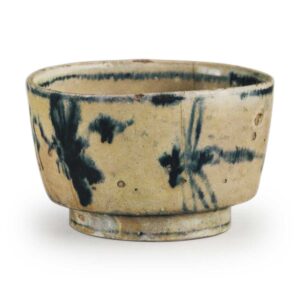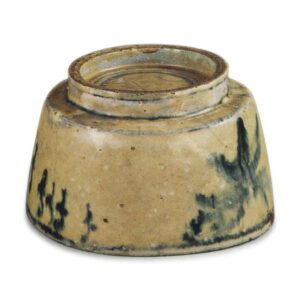

Tokugawa Art Museum
Height: 6.3-6.5cm
Diameter: 9.4-11.2cm
Outer diameter of foot: 6.9cm
Height of foot: 1.2cm
Tea bowls for powdered green tea are extremely rare in countries other than Japan, Korea and China, but this is one of the few examples from Annam. It is one of the types commonly referred to as Annam tie-dye, Annam gosu and Annam dragonfly-shaped, and it is a superb bowl with the desired dragonfly design and the perfect combination of features.
The foot ring is only attached to the foot of the bowl, so it is difficult to say for sure, but it is made of a gray, hard clay, and it may be considered to be half-porcelain. The clay color is not very vivid, so it seems that a white slip was applied to the surface. The fact that the glaze is peeling off in places is because the slip is weak and has peeled off from the surface. The fingerprints on the foot ring are faded and have turned a mouse color, and there are triangular-shaped marks on the inside wall where the glaze has flaked off, which suggests that the piece was glazed.
The shape is semi-cylindrical, and the foot ring is quite high, but the size is also unusual, so it is stable and solid. The bowl is severely distorted when viewed from above, but I don’t think that this is due to the intense firing. When you hold this bowl in your hand, it feels very comfortable to hold, and this is probably due to the degree of distortion. For this reason, I think that this bowl was made from the beginning as a tea bowl, or in other words, it was made to order from Japan. The glaze of the An-Nan-dyeing is not as refined as that of China, so the color is black and sometimes it blows iron sand.
And the water glaze that covers it is weak, so the dyeing is unstable and it flows and blots out. It looks just like the pattern of tie-dyeing, so the name “Shiborite” was born. This teacup is also a fine example of shibori-te. The pattern on the outside has two tonbo on one side – the first one has a dark blue feather design, and the body is interrupted, making it look like a butterfly – on the other side, there is another tonbo that also looks like a butterfly, and a small flock of five or six tonbo that are drawn in a staggered formation. The interior is plain, but there is a simple pattern of autumn flowers in the center of the interior. Both inside and out, the rim and the bottom edge are outlined with a line of underglaze blue. Similarly, a line is also drawn around the base of the foot ring, and these lines give the tea bowl a sense of solidity.
As you can see in the photo, the surface of the bowl is quite yellow. This is because the makeup clay and the glaze are both of poor quality, but this in turn harmonizes well with the dark underglaze color. Normally, Anan bowls of this type are filled with iron sand inside the foot ring, but this bowl does not have this. Tea masters considered it good that it did not have iron sand, so in that sense, too, this can be said to be a first-class tea bowl.
It is said that Anan tea bowls were imported from the end of the Momoyama period to the beginning of the Edo period, when the southern sea trade was flourishing, but the shape, which is suitable for the hand, and the tone of the soft, broken pattern, probably indicate that they were special products made to order in Japan.
This tea bowl was originally in the Okaya family’s storehouse in Nagoya, and is inscribed with the name “Tsukimi”. The origin of the name is not clear.



